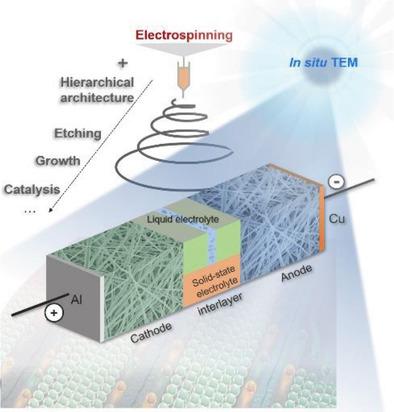当前位置:
X-MOL 学术
›
Adv. Energy Mater.
›
论文详情
Our official English website, www.x-mol.net, welcomes your
feedback! (Note: you will need to create a separate account there.)
Electrospinning‐Based Strategies for Battery Materials
Advanced Energy Materials ( IF 24.4 ) Pub Date : 2020-06-24 , DOI: 10.1002/aenm.202000845 Xiaoyan Li 1 , Weichen Chen 2 , Qingrong Qian 1 , Haitao Huang 3 , Yuming Chen 1, 4 , Ziqiang Wang 4 , Qinghua Chen 1, 5 , Jing Yang 6 , Ju Li 4 , Yiu‐Wing Mai 7
Advanced Energy Materials ( IF 24.4 ) Pub Date : 2020-06-24 , DOI: 10.1002/aenm.202000845 Xiaoyan Li 1 , Weichen Chen 2 , Qingrong Qian 1 , Haitao Huang 3 , Yuming Chen 1, 4 , Ziqiang Wang 4 , Qinghua Chen 1, 5 , Jing Yang 6 , Ju Li 4 , Yiu‐Wing Mai 7
Affiliation

|
Electrospinning is a popular technique to prepare 1D tubular/fibrous nanomaterials that assemble into 2D/3D architectures. When combined with other material processing techniques such as chemical vapor deposition and hydrothermal treatment, electrospinning enables powerful synthesis strategies that can tailor structural and compositional features of energy storage materials. Herein, a simple description is given of the basic electrospinning technique and its combination with other synthetic approaches. Then its employment in the preparation of frameworks and scaffolds with various functions is introduced, e.g., a graphitic tubular network to enhance the electronic conductivity and structural integrity of the electrodes. Current developments in 3D scaffold structures as a host for Li metal anodes, sulfur cathodes, membrane separators, or as a 3D matrix for polymeric solid‐state electrolytes for rechargeable batteries are presented. The use of 1D electrospun nanomaterials as a nanoreactor for in situ transmission electron microscopy (TEM) observations of the mechanisms of materials synthesis and electrochemical reactions is summarized, which has gained popularity due to easy mechanical manipulation, electron transparency, electronic conductivity, and the easy prepositioning of complex chemical ingredients by liquid‐solution processing. Finally, an outlook on industrial production and future challenges for energy storage materials is given.
中文翻译:

基于静电纺的电池材料策略
电纺丝是制备组装成2D / 3D体系结构的1D管状/纤维纳米材料的流行技术。当与其他材料处理技术(例如化学气相沉积和水热处理)结合使用时,静电纺丝可以实现强大的合成策略,从而可以调整储能材料的结构和组成特征。在此,对基本的电纺丝技术及其与其他合成方法的组合进行简单描述。然后介绍其在制备具有各种功能的框架和支架中的用途,例如,石墨管状网络以增强电极的电子导电性和结构完整性。3D支架结构作为锂金属阳极,硫阴极,膜分离器,或作为3D矩阵用于可充电电池的聚合物固态电解质。总结了将一维电纺纳米材料用作纳米反应器进行材料合成和电化学反应机理的原位透射电子显微镜(TEM)观察的方法,该方法因易于机械操作,电子透明性,电导率和易操作性而广受欢迎通过液体溶液处理对复杂的化学成分进行预定位。最后,给出了工业生产的前景以及储能材料的未来挑战。总结了将一维电纺纳米材料用作纳米反应器进行材料合成和电化学反应机理的原位透射电子显微镜(TEM)观察的方法,该方法因易于机械操作,电子透明性,电导率和易操作性而广受欢迎通过液体溶液处理对复杂的化学成分进行预定位。最后,给出了工业生产的前景以及储能材料的未来挑战。总结了将一维电纺纳米材料用作纳米反应器进行材料合成和电化学反应机理的原位透射电子显微镜(TEM)观察的方法,该方法因易于机械操作,电子透明性,电导率和易操作性而广受欢迎通过液体溶液处理对复杂的化学成分进行预定位。最后,给出了工业生产的前景以及储能材料的未来挑战。
更新日期:2020-06-24
中文翻译:

基于静电纺的电池材料策略
电纺丝是制备组装成2D / 3D体系结构的1D管状/纤维纳米材料的流行技术。当与其他材料处理技术(例如化学气相沉积和水热处理)结合使用时,静电纺丝可以实现强大的合成策略,从而可以调整储能材料的结构和组成特征。在此,对基本的电纺丝技术及其与其他合成方法的组合进行简单描述。然后介绍其在制备具有各种功能的框架和支架中的用途,例如,石墨管状网络以增强电极的电子导电性和结构完整性。3D支架结构作为锂金属阳极,硫阴极,膜分离器,或作为3D矩阵用于可充电电池的聚合物固态电解质。总结了将一维电纺纳米材料用作纳米反应器进行材料合成和电化学反应机理的原位透射电子显微镜(TEM)观察的方法,该方法因易于机械操作,电子透明性,电导率和易操作性而广受欢迎通过液体溶液处理对复杂的化学成分进行预定位。最后,给出了工业生产的前景以及储能材料的未来挑战。总结了将一维电纺纳米材料用作纳米反应器进行材料合成和电化学反应机理的原位透射电子显微镜(TEM)观察的方法,该方法因易于机械操作,电子透明性,电导率和易操作性而广受欢迎通过液体溶液处理对复杂的化学成分进行预定位。最后,给出了工业生产的前景以及储能材料的未来挑战。总结了将一维电纺纳米材料用作纳米反应器进行材料合成和电化学反应机理的原位透射电子显微镜(TEM)观察的方法,该方法因易于机械操作,电子透明性,电导率和易操作性而广受欢迎通过液体溶液处理对复杂的化学成分进行预定位。最后,给出了工业生产的前景以及储能材料的未来挑战。











































 京公网安备 11010802027423号
京公网安备 11010802027423号